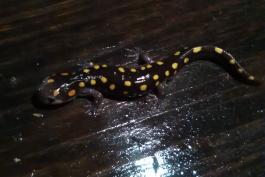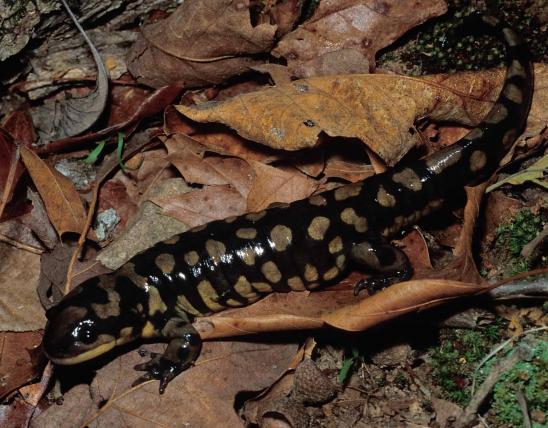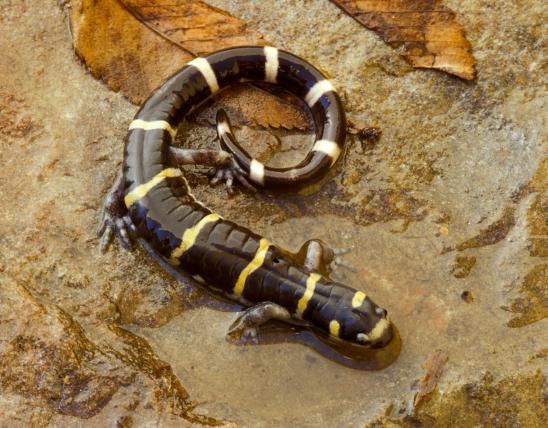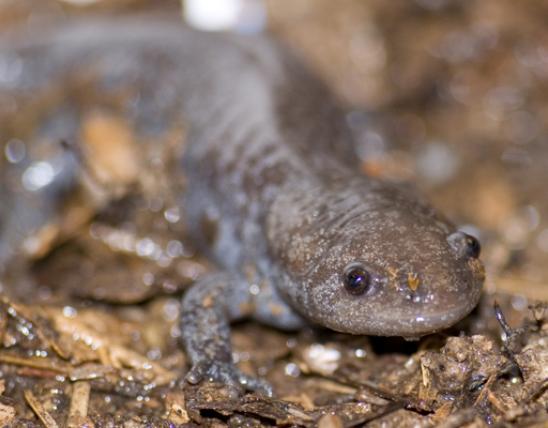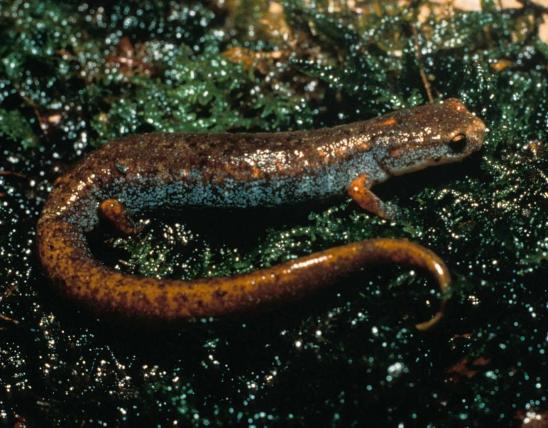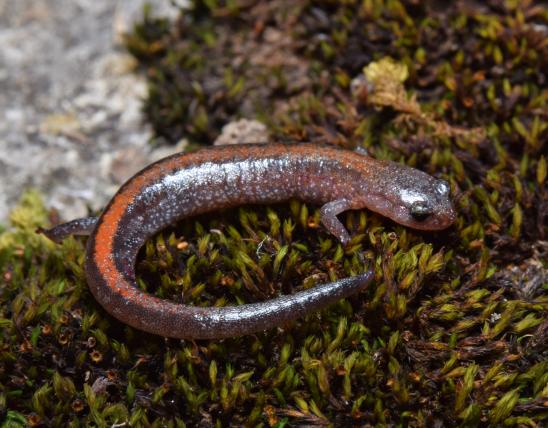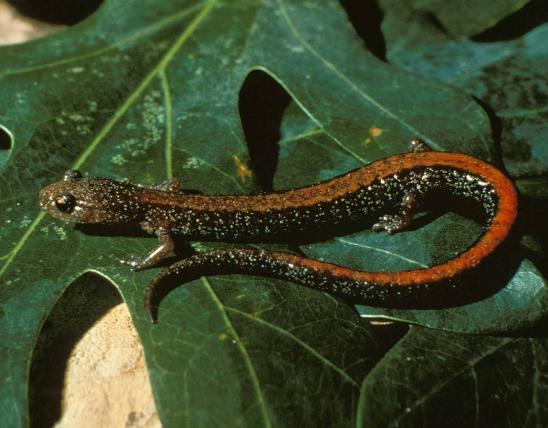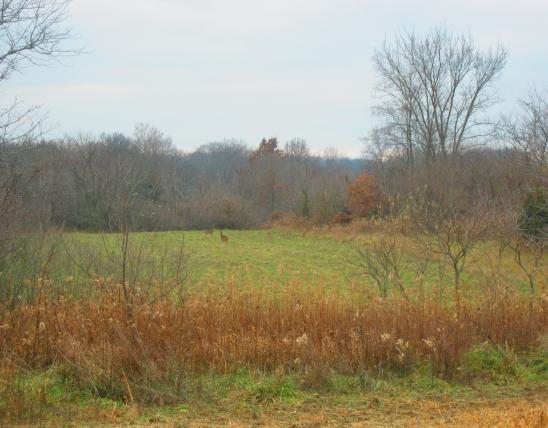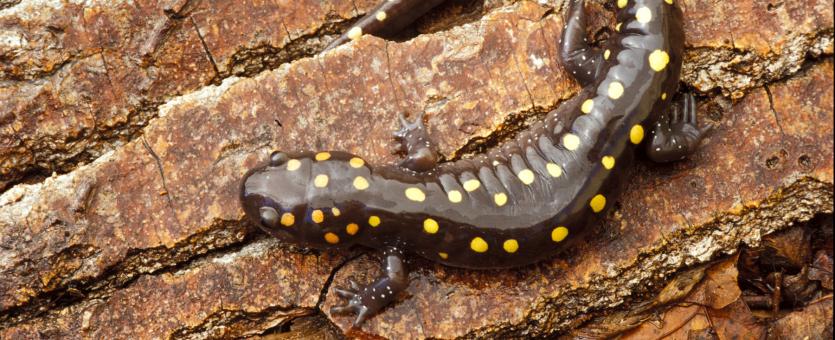
The spotted salamander's main color is slate black, with a dark gray belly. There are 2 irregular rows of rounded yellow spots from the head onto the tail. The total number of yellow spots is 17–78. Some Missouri specimens may lack most or all yellow spots. The spots on the head may be bright orange. The sides of the head, neck, and body usually have small white flecks. There are 11–13 riblike costal grooves along the side.
Similar species: This is one of six Missouri species of mole salamanders (family Ambystomatidae); all six are in genus Ambystoma. This is the only one with rounded yellow spots.
Adult length: 4½–7¾ inches; occasionally to 10 inches.
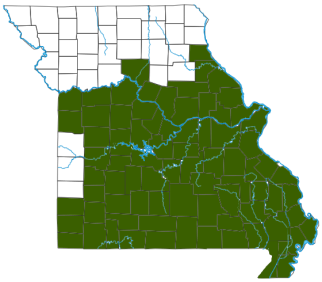
Occurs in forested habitats throughout the southern two-thirds of the state, except it is uncommon in the eastern part of the Bootheel.
Habitat and Conservation
This species lives in damp hardwood forests in places near shallow ponds, usually hidden under logs or rocks, inside piles of dead leaves, or in burrows of other small animals. They leave their shelters at night to seek food. People sometimes see them as they cross roads on warm, rainy nights in late winter or early spring.
Spotted salamanders, especially juveniles, may occasionally climb into vegetation to a height of about 3 feet.
Generally speaking, members of the mole salamander family spend most of their time underground. Outside of breeding season, adults spend most of their time in the soil (often in burrows made by small mammals) or under logs and rocks. Salamanders in this family are often active at night, especially after a heavy rain.
Food
They venture out at night to forage for worms, insects, spiders, and land snails.
Status
Locally common.
Life Cycle
Spotted salamanders breed in late winter to early spring. Rainfall and warming temperatures, occurring after freezing weather, stimulate breeding migrations. During the first warm rains in late February to mid-March, they gather to breed in shallow, fishless woodland ponds.
The courting salamanders, sometimes numbering more than 1,000, engage in a sort of nuptial dance in shallow water. The next day, the stalks of jelly, nearly covering the bottom of a pond, may be found as evidence of the previous nights’ breeding frenzy.
The eggs are fertilized as they are laid, on submerged branches or aquatic plants, within 1–2 days of courtship. The larvae hatch in about 4–6 weeks and live in the water. Most larvae leave the pond from mid-June through early September, but some may overwinter in the pond and transform into adults the following spring. Many individuals will return to the same pond to breed year after year.
Spotted salamanders become reproductively mature in 2 or more years; they may live more than 20 years in captivity.
Human Connections
Keeping this species common in Missouri requires management that focuses on conserving the small, fishless ponds necessary for breeding and larval growth. These ponds need to be in large, intact forests. Preserving an approximately 600- to 1,600-foot buffer of mature forest around breeding wetlands is important for maintaining healthy populations of the spotted salamander.
Dancing salamanders? Hundreds of them all at once? In the water? That’s how spotted salamanders create their next generation, in only a few springtime evenings each year. If you witness this event, consider yourself lucky!
Ecosystem Connections
Like other mole salamanders, spotted salamanders are predators of smaller creatures, but though they are predators of insects, worms, and slugs, they, along with their eggs and juvenile forms, provide food for many other hungry animals.
A certain type of green, single-celled algae (Oophila amblystomatis) usually grows in the egg masses of spotted salamanders. This algae actually grows directly on the early stages of the developing embryos within the egg capsule. The algae is transmitted to the embryo either from the pond water or from the parents. After about a week or so, the developing egg and egg capsule takes on a light green color due to the algae. Apparently, this is a type of symbiotic relationship: the algae provide oxygen to the embryos, and the developing larvae provide carbon dioxide and waste products that function as nutrients for the algae.
Spotted salamanders are linked to small mammals. A study in New York state showed that spotted salamanders spend most of their time during the active season in shallow burrows made by short-tailed shrews, and that they spend winter in the deeper burrows of white-footed mice. The population size of spotted salamanders is influenced by the availability of small-mammal burrows.
A genetic study of spotted salamanders in several midwestern states showed that this species may not have moved into Missouri until around 5,000 years ago, long after the retreat of the Wisconsin glacier.




